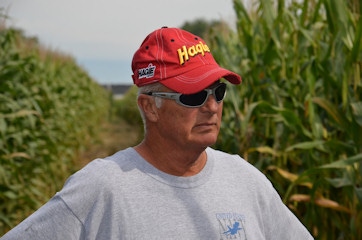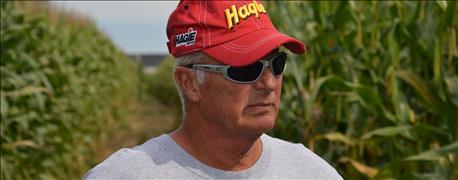
Do you ever wonder if you should be applying nitrogen in different ways or at different times than you do now? Or are you thinking that maybe you could cut back on your corn seeding rate or soybean population and increase your bottom line?

HARVEST THE RESULTS: Ken Simpson has worked with his county Extension educator and Purdue specialists on on-farm plots for the past three years.
You can look online or read information from universities and seed companies, but you may get opinions all over the board. For example, we recently carried information from Purdue University saying that researchers aren’t finding differences in yield based on whether N is applied at sidedressing in one shot, or is applied in split applications. Yet an independent source from Ohio recently sent out information showing a big payback for split-applications last year. Who is right? Isn’t what really matters is what works on your farm over time?
Here are two opportunities to begin testing these kinds of practices, with outside help to make sure the tests are accurate:
1. Purdue on-farm testing opportunities
Several agronomists at Purdue look for farmers who are willing to work with them in on-farm, field-size trials on various topics. Bob Nielsen, Purdue Extension corn specialist and Jim Camberato, Extension soil fertility specialist, have been doing on-farm trials for several years to test things such as nitrogen rates for corn and nitrogen timing. Other Extension personnel looking for on-farm cooperators are Kiersten Wise, a plant pathologist who likes to test fungicide application efficacy and timing, and Shaun Casteel, soybean specialist, who tests seeding rates and other factors.
“It’s easier to do today with yield monitors and precision-farming application equipment,” Nielsen has stated at field days before. “We believe we get better information working in on-farm, large-scale plots for the type of things we’re testing. “
If you would like more information about being a cooperator, email Nielsen at: [email protected], or contact your county Extension educator.

LEARN AND SHARE: Ken Simpson, a plot cooperator with Purdue, worked with Shelby County Extension ag educator Scott Gabbard to host a field day last fall in his trial field. Here, Kiersten Wise discussed fungicide application timing.
2. INfield Advantage advanced level testing program
This program is offered through the Indiana State Department of Agriculture. Meg Leader is in charge of the program. Most people are in a basic level that does not involve plot work, but there are some farmers who take advantage of the advanced level to compare different practices.
“The advanced level of the program allows the grower to use our tools to do on-farm research focused on a management question,” Leader says. “We refer to it as Replicated Strip Trial. For RST fields, we require that the grower has a GPS-equipped yield monitor and is willing to download and share yield data so our analyst can do a statistical analysis. RST fields have a more extensive registration form where the different strip treatments can be described.
Traditionally, RST has compared different nitrogen rates, Leader notes. “In 2015 we had N strip trials comparing different timings as well as the impact of different cover crops in the following crop and interseeded into this year’s crop,” she explains. “Looking ahead, I expect to start including cover crop trials in beans and wheat as well as some population studies.”
To learn about INField Advantage, visit INfieldAdvantage.org.

TRY, AND LEARN: What makes INfield Advantage unique, Leader says, is that a farmer is part of a group, and the group has a winter meeting to share and discuss results. (Photo courtesy of Meg Leader)
About the Author(s)
You May Also Like




